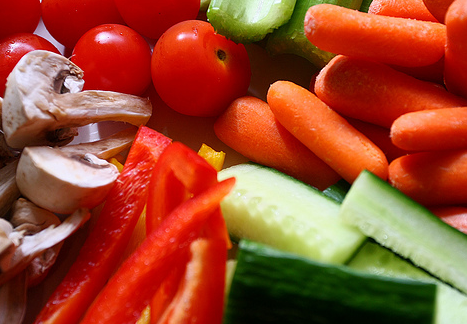
The recommendation is to eat at least five servings of fruit and vegetables per day, but most adults are falling short of this level. For people who are trying to lose weight, are trying to lose stomach fat or following a weight loss plan upping the daily intake of vegetables will not only improve health, but will also speed up the rate at which weight is lost.
Calories and Fibre
Vegetables are low in calories compared with many other food items and are therefore a good choice for anyone who is trying to reduce the number of calories that they eat. Vegetables are also high in dietary fibre. Foods rich in fibre take longer to digest and therefore keeps you feeling fuller for longer than foods which are low in fibre. Eating lots of fibre helps to keep the digestive system healthy and has been proven to protect against bowel cancer.
Top Ten Vegetables to Eat for Weight Loss
Although all vegetables are good, some vegetables are higher in nutrients and fibre than others. Knowing which vegetables have the highest concentration of nutrients should help you decide which to incorporate into your diet.
- Broccoli. This green vegetable is both low in calories and high in nutrients. The carbohydrates which make up broccoli are complex, meaning that broccoli takes a long time to digest and will leave you feeling fuller for longer. It is also high in Vitamin E, calcium, iron and magnesium.
- Cabbage. Cabbage also is very low in calories and full of nutrients such as Vitamin A, copper and thiamin. One of the main benefits of cabbage is that it can be eaten raw in a salad or quickly cooked and added to a stir fry or served as an accompanying vegetable.
- Spinach. Although it may not give you muscles like Popeye, spinach contains high levels of vitamins, iron and minerals and is high in fibre. Like cabbage, it can be eaten raw as a salad vegetable, steamed or stir fried.
- Leeks. This is another vegetable which is packed with complex carbohydrates and will keep you feeling full. Leeks cannot be eaten raw, but can be used in pies, soups or cooked to go with most sorts of meals.
- Carrots. The orange colour of a carrot comes from beta-carotene, which has been proven to be beneficial to eyesight. Carrots are sweet and tasty, and make an ideal snack. They are very versatile and can be eaten raw, cooked or incorporated into soups
- Sweet Potato. The sweet potato differs from regular white potatoes as they are a complex carbohydrate which takes a long time to digest. They are also far higher in vitamins and minerals than normal potatoes, and they can be baked in the oven or added into stews or soups.
- Eggplant. Eggplants are high in fibre and are an excellent source of folate, one of the B vitamins which helps the body process protein in the diet.
- Tomato. Although strictly speaking a fruit, tomatoes are low in calories and high in fibre. Lycopene, a chemical found in tomatoes has been proven to help prevent against developing cancer.
- Capsicum peppers. Capsicums are one of the best sources of Vitamin C and are very low in calories. They can be eaten raw or cooked, and are equally good made into a soup and are also one of our picks for the best metabolism boosting foods.
- Mushrooms. Large mushrooms, such as the Portobello variety, can be used as a meat substitute to lower the calorie content of a meal. They are high in protein and low in calories.
To see our list of recipes which include all these veggies in click here
